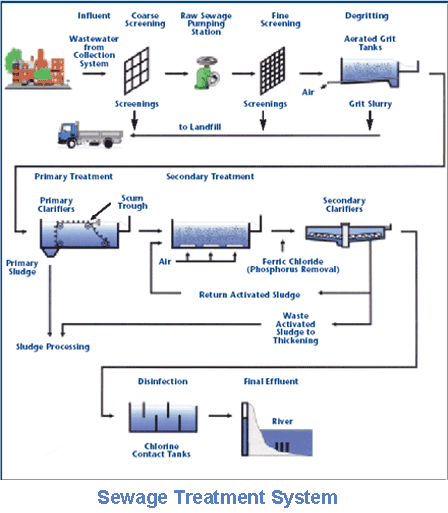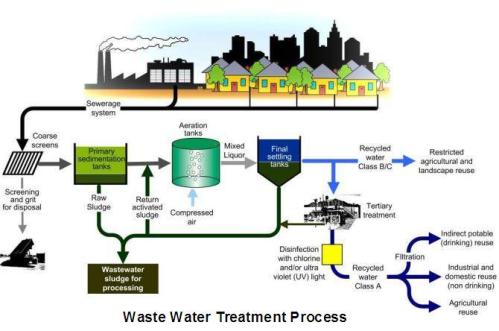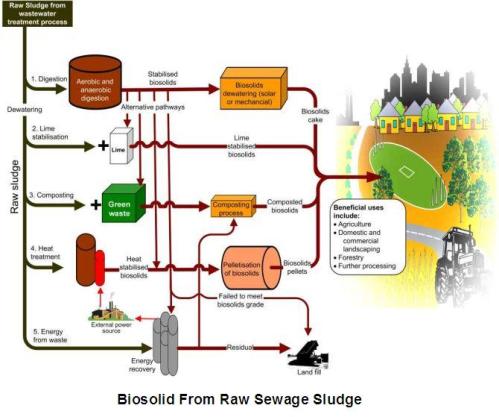Sewage Treatment – For recycling of waste
water, use of biosolids and to generate renewable energy for cleaner,
safer and greener environment:
Introduction - In urban areas sewage is created by residences, institutions, hospitals and commercial and industrial establishments. Sewage
treatment and disposal system is an important function for any city
planner, in order to recycle the used water. It is the ultimate return
of used water to the environment. Discharge to the environment must be
accomplished without transmitting diseases, endangering aquatic
organisms, impairing the soil.
Sewage treatment is an artificial process
to which sewage is subjected in order to remove or alter its
objectionable constituents and to render it less dangerous from the
standpoint of public health. Wastewater is treated to remove
contaminants or pollutants that affect water quality. The treated
wastewater is recycled / reused for gardening, irrigation, flushing etc.
Disposal system has arrangements to distribute the used water either to
aquatic bodies such as oceans, rivers, lakes, ponds, or lagoons or to
land by absorption systems, groundwater recharge, and irrigation. Waste
water must be mixed, diluted and absorbed before it is discharged to the
general body of water, so that the receiving environments do not lose
its beneficial usable characteristics; such as drinking, bathing,
recreation, aquaculture, irrigation, groundwater recharge, industry etc.
Water quality standards relate to the esthetics and use of the
receiving environment for public water supply, recreation, maintenance
of aquatic life and wildlife, or agriculture. The parameters of water
quality, which define the physical, chemical, and biological limits,
include floating and settleable solids, turbidity, color, temperature,
pH, dissolved oxygen, biochemical oxygen demand (BOD), toxic materials,
heavy metals, and nutrients.
Sewage can be treated close to
where it is created (in septic tanks, bio-filters or aerobic treatment
systems), or may be collected and transported via a network of pipes and
pump stations to a municipal treatment plant.
Sewage treatment, as mentioned earlier, is
the physical, chemical and biological processes used to clean industrial
and domestic wastewater and has improved significantly over the past 20
years. However, the energy requirement to treat sewage to the highest
standard has been quite large. Further tightening of water quality
standards, especially in developed nations; suggest energy costs will
increase substantially in future. We will discuss here about possibility
of renewable energy generation from sewage, to offset the extra energy
requirement for sewage treatment and also to use surplus energy for
domestic purpose. In fact, the actual energy used will depend on the
quality of sewage and intensity of treatment required.
 A. Typically, sewage treatment involves three stages, called (a) primary, (b) secondary and (c) tertiary treatment:
A. Typically, sewage treatment involves three stages, called (a) primary, (b) secondary and (c) tertiary treatment:
(a) Primary – Broadly, solids are physically settled out. Primary
sewage treatment removes larger floating objects through screening and
sedimentation. The incoming wastewater flows through one or more screens
and then enters a grit chamber where it slows down enough to allow
sand, gravel, and other inorganic matter to settle out. In treatment
plants where only primary treatment occurs, the effluent is chlorinated
and discharged into circulation in a water source. The sludge, or
sedimentation of larger solids, is removed, dried, and disposed of.
Primary treatment removes 50 to 65 percent of suspended solids and
decreases biological oxygen demand (BOD) by 25 to 40 percent. Primary
treatment alone is not considered adequate for protection of the
environment or people’s health.
(b) Secondary - Bacteria convert organic matter to a carbon-rich sludge. Secondary
treatment relates to processes similar to natural biological
decomposition. Aerobic bacteria and other microorganisms are used to
break down organic materials into inorganic carbon dioxide, water, and
minerals. Trickling filters, which are made from a bed of rocks with a
microbial covering, are used to absorb the organic material present in
the water. Activated sludge processes can be used in place of trickling
filters. The level of suspended solids and BOD in wastewater after
primary and secondary treatment has been decreased by 90 to 95 percent.
This level of treatment is not effective in removing viruses, heavy
metals, dissolved minerals, or certain chemicals.
(c) Tertiary (advanced treatment)- Further treatment may be used to remove more organic matter and/or disinfect the water. Tertiary
treatment is an advanced level of treatment. This form of treatment can
decrease the level of suspended solids and BOD to approximately 1
percent of what was present in the raw sewage prior to primary
treatment. Advanced treatment processes consist of several biological,
chemical or physical mechanisms. Sewage treatment aims to destroy
pathogenic organisms. Since primary and secondary treatments do not
destroy a significant number of organisms, chlorination, which is
effective in killing bacteria, is used to disinfect treated effluent.
Before the final effluent is released into the receiving waters, it may
be disinfected to reduce the disease-causing microorganisms that remain
in it. The most common processes use chlorine gas or a chlorine-based
disinfectant such as sodium hypochlorite. To avoid excess chlorine
escaping to the environment, the effluent may be dechlorinated prior to
discharge.
Most advanced wastewater treatment systems
include de-nitrification and ammonia stripping, carbon adsorption of
trace organics, and chemical precipitation. Evaporation, distillation,
electro-dialysis, ultra-filtration, reverse osmosis, freeze drying,
freeze-thaw, floatation, and land application, with particular emphasis
on the increased use of natural and constructed wetlands, are being
studied and utilized as methods for advanced wastewater treatment to
improve the quality of the treated discharge to reduce unwanted effects
on the receiving environment. Other disinfection options include
ultraviolet light and ozone.
The effluent is generally discharged to
fresh, ground or coastal water. Sludge is applied to agricultural land,
incinerated, used for land reclamation or used for other purposes, such
as composting or landfill etc.
B. In order to increase
energy efficiency of water treatment and reuse of treated water few
points have been mentioned below. By implementing these measures energy
savings and efficiency of about 40% may be achieved. These are:
(a) Choosing low-energy treatment options, if possible. However, local constraints may limit choice.
(b) Replacing machine parts, such as pumps and motors, with more efficient versions.
(c) Optimizing processes using sensor technology. For example, pumping can be adjusted according to flow.
(d) Reusing water. “Greywater” from bathing,
laundry and washing dishes can be reused to flush WCs. This may provide
savings of around a third of daily household water demand.

 C. Biosolids -
Biosolids are treated sewage sludges. Sewage sludge is the solids that
are collected from the wastewater treatment process but which have not
undergone further treatment. Sludge normally contains up to around 3 %
solids. Biosolids are a product of the sewage sludge once it has
undergone further treatment to reduce disease causing pathogens and
volatile organic matter significantly, producing a stabilised product
suitable for beneficial use. Biosolids, normally contain between 15 % to
90 % solids. Biosolids are carefully treated and monitored and they
must be used in accordance with regulatory requirements.
C. Biosolids -
Biosolids are treated sewage sludges. Sewage sludge is the solids that
are collected from the wastewater treatment process but which have not
undergone further treatment. Sludge normally contains up to around 3 %
solids. Biosolids are a product of the sewage sludge once it has
undergone further treatment to reduce disease causing pathogens and
volatile organic matter significantly, producing a stabilised product
suitable for beneficial use. Biosolids, normally contain between 15 % to
90 % solids. Biosolids are carefully treated and monitored and they
must be used in accordance with regulatory requirements.
Biosolids can be applied as a fertiliser to
improve and maintain productive soils and stimulate plant growth. They
are also used to fertilise gardens and parks and reclaim mining
sites. In many of the developed countries biosolids have been used for:
- Co-generation/power production/energy recover
- Land application in agriculture (vine, cereal, pasture, olive)
- Road base
- Land application in forestry operations
- Land rehabilitation (including landfill capping)
- Landscaping and topsoil
- Composting
- Incineration
- Landfill
- Oil from sludge (experimental).
D. Energy generation – There
are mature, widely-practiced technologies for generating fuels from
sewage treatment. Moreover, research has identified future methods for
exploiting sewage as an energy resource as well.
1. Current Technologies for Energy Production –
(a) Sludge Incineration -
Most of the sewage sludge produced at sewage treatment plant is applied
to agricultural land as a soil conditioner, reducing the need for
fertilizer. Sludge may also be incinerated, with the option of energy
recovery. However, to incinerate sludge, it must be dry enough to burn
with no extra energy input other than that needed to fire up the
incinerator. It therefore needs dewatering, using energy intensive
processes such as centrifugation or thermal dehydration. Centrifugation
requires less energy but surplus heat from incineration that can be used
for thermal dehydration. There has been strong opposition from some
sections of the public over incineration of wastes due to fears about
impacts on human health. At present, reuse of sludge via application to
land is generally considered a more acceptable option.
(b) Biogas –
Biogas production from sewage sludge treatment, via a process called
anaerobic digestion, is already a well established means of generating
energy in many developed countries. Bacteria used to organic matter in
sludge to produce a mixture of methane (CH4 of 60 – 65%), carbon dioxide
(CO2 of 35 – 40%) and trace gases. Impurities, such as hydrogen sulfide
and water, are removed and the resulting biogas is then commonly used
in boilers or combined heat and power systems. Biogas may also be used
for other applications, such as vehicle fuel, if CO2 is also removed.
Anaerobic digestion also reduces the solids content of sludge by up to
30%, reducing the energy costs involved in its transport.
Please also refer : Energy from sewage
2. Future Technologies for Energy Production
– There are several novel technologies that produce energy or fuel as a
by-product of sewage treatment, although further work is needed to
improve performance, reliability and cost-effectiveness.
(a) Conversion of sludge to oil and gas -
Under carefully controlled conditions and extreme temperatures (450 –
1000 degree Celsius), sludge may undergo chemical reactions to produce
fuels that may be used for energy production. Processes include
gasification, which produces syngas (similar to natural gas), and
pyrolysis, which produces bio-oil (similar to diesel oil). There is
interest in these as potential alternatives to incineration of sludge.
However, operational costs are high, particularly those of maintaining
high temperatures, and conditions must be carefully controlled to
prevent formation of harmful by-products, such as hydrogen cyanide.
(b) Biomass Crops -
In some of the European countries, sewage sludge is applied as
fertilizer to willow plantations. The trees are periodically coppiced
and the wood used for fuel. Research into applying partially-treated,
liquid sewage to biomass crops is also underway. Passage of the sewage
through the soil acts as a final polishing step for treatment, degrading
organic matter, reducing nitrogen and phosphorus and producing a
cleaner effluent. Little energy is required and capital and operational
costs are low. However, it is not yet known how efficient this system
will be at removing pollution and there must be appropriate land
available.
(c) Hydrogen from Sewage -
There is much interest in hydrogen as a fuel, because it can be
produced from a wide range of materials and provides power with minimal
air pollution. Bacteria use organic matter to produce hydrogen by
fermentation. However, applications for hydrogen, such as fuel cells,
are not yet in widespread use.
(d) Microbial Fuel Cells -
These devices offer the possibility of simultaneous sewage treatment
and energy production, with water, CO2 and inorganic residue as
by-products. Bacteria use organic matter to produce electricity. To
date, only lab-scale microbial fuel cells have been developed in some of
the developed countries that are able to power small devices.
E. Discussion on energy conservation and renewable energy in relation to sewage treatment system –
(a) Energy
conservation is possible through the twin practices of efficient water
use by consumers and efficient energy use by the water industry.
(b) There are
well-established renewable energy options, such as biogas, and novel
technologies, such as gasification, for sewage treatment. Many need
further investment and research.
(c) Economic
and water quality considerations are key drivers for the water industry.
Integration of energy related objectives into the existing regulatory
framework will be necessary.
F. Methane from Biogas – A renewable source of green energy to be encouraged to generate –
Anaerobic digestion of wastes provides biogas.
Biogas contains about 60% methane that can be used to generate
electricity or used for heat or for fuel for vehicles. Any animal
manure, human sewage or food waste will produce methane during anaerobic
digestion. Natural gas is methane. Biogas can be “cleaned” to yield
purified methane that can be used in the natural gas pipelines.
Methane from biogas is an excellent alternative energy source. Using
methane for energy helps the environment by replacing the use of
non-renewable fossil fuels with renewable energy. Methane is a
greenhouse gas that has 21 times the heating effect as of carbon
dioxide. Biogas methane is renewable unlike natural gas which is mined
from underground wells and is a non-renewable fossil fuel. Methane
biogas is about to become much more important as an energy source than
it has been in the past, due to the ever rising cost of natural gas.
i) Some facts about methane biogas –
(a) Millions of cubic metres of methane in the form
of swamp gas or biogas are produced every year by the decomposition of
organic matter, both animal and vegetable.
(b) It is almost identical to the natural gas
pumped out of the ground by the oil companies and used by many of us for
heating our houses and cooking our meals.
(c) Many countries have for years been steadily
building anaerobic digestion facilities for generating electricity from
methane produced from manure, sewage and garbage.
(d) Villagers in many undeveloped countries use
very simple technology to convert animal and human wastes to biogas for
cooking and heating.
(e) Recently hundreds of farms in India, Mexico and
South America have installed anaerobic digesters to collect and use
methane from manure to provide energy for farm use. Many of these
digesters have been paid for by a company that aggregates and sells
carbon credits to factories and utility companies in countries that
signed agreements under the Kyoto protocol to reduce greenhouse
emissions. Carbon credits are earned by reducing greenhouse gas
emissions such as carbon dioxide and methane. These credits have
considerable value.
(f) In the U.S., which rejected the Kyoto protocol,
most of the methane from wastes is allowed to escape into the
atmosphere where it contributes to global warming. However there are
about a hundred or so dairy farms, a few pig farms, some landfills and a
few municipal sewage treatment plants in the U.S. that are collecting
methane from waste and using it for fuel.
ii) Unbelievable as it may
seem, at this time of approaching energy crisis, most farmers can’t get
utility companies to purchase their green, renewable electricity.
Possible reasons for this reluctance on the part of electrical utilities
range from lack of familiarity with connecting farm generators to
pressure from coal and oil companies to maintain monopoly of the utility
market. Without the ability to sell the excess power generated from
methane farmers or others with sources of methane can’t afford to
install the equipment for collecting methane and generating power as
this usually means an investment of a million or more dollars.
iii) This kind of situation needs
change. Countries where the production of methane from biogas is not
practiced, realizing the seriousness of global warming and problems
associated with fossil fuel usage, “green energy” generated from sources
such as wind, biomass and, in a few cases, bio-methane are to be
encouraged by law. Moreover, consumer pressure will likely be needed to
motivate more electric utilities to purchase electricity generated from
renewable methane thus ensuring energy security.
iv) Biogas from manure or
other wastes can be purified to yield pipeline grade methane. With the
increase in price of natural gas it has become economically feasible in
some cases to remove impurities from the methane and sell it to
companies supplying natural gas (methane is chemically the same as
natural gas). Due to the energy that must be used to clean, compress and
transport the gas this is usually not as efficient a route for using
methane as feeding it directly into a generator but, unless electric
utility companies become willing to pay a fair price for electricity
generated from farm methane, selling gas for pipeline use may become a
more common practice.
[ For more refer ‘ Water Conservation – Need-of-the-day for our very survival ‘ ]
References:
- http://environmentengineering.blogspot.com/2008/06/methane-from-biogas-renewable-source-of.html
- http://environmentengineering.blogspot.com/2008/06/energy-from-sewage-renewable-energy-to.html
The blog is showing all the experience and skill s of the writer, for assistance associated with the packaged type sewage treatment plant in Haryana the person can anytime connect with the team at clear Ion.
ReplyDeleteI Like to add one more important thing here, The analysts forecast global Bio solids market for the mining sector to grow at a CAGR of 5.0% during the period 2019-2025.
ReplyDelete